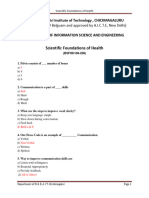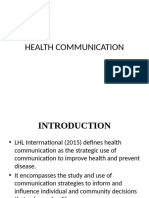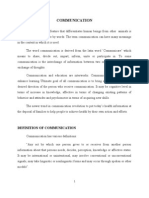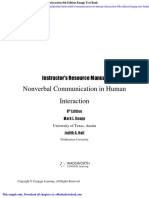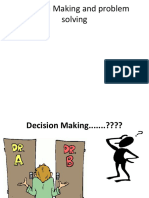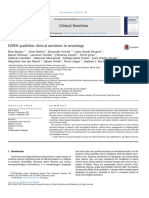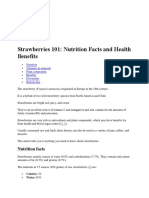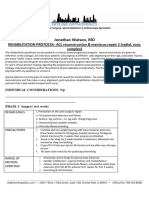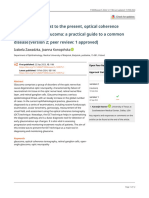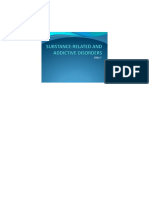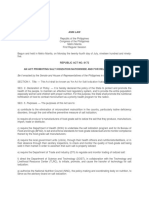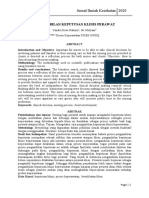Course Name: Scientific foundation for Health with Yoga Course Code: 22SFH18/22SFH28
Module-3: Creation of Healthy and caring relationships
1. A type of communication in which receiver has the chance of asking questions and clearing doubts
a. One-way communication
b. Two – way communication
c. Non-verbal communication
d. None of the above
2. What is a sign of a toxic friendship
a. Lack of empathy
b. Laughing and giving hugs
c. Being supportive
d. Pushing you hard to be better person
3. Personal contact is ------------- communication
a. Face-to-face
b. Mass
c. Both a and b
d. None of the above
4. -------------- is a communication method in which speakers speak ‘for’ or ‘against’ the statement
a. Lecture
b. Field trip
c. Debate
d. Simulated learning experience
5. Why human need friendship
a. Humans are social being
b. Humans see profits
c. Humans want food
d. Humans need shelter
6. Body language plays an important role in
a. Communication
b. Judgement
c. Both a and b
d. None of the above
7. Important role of health is
a. Fighting diseases
b. Felling happy
c. Enjoy life
d. All of the above
8. How to be mindfulness daily
a. Take deep breath while shifting the task
b. Practice meditation
c. Listen to your body
d. All of the above
Prepared by Dr. N. Mahesha, Associate Professor, Department of Civil engineering, New Horizon College of Engineering, Bangalore-103
� Course Name: Scientific foundation for Health with Yoga Course Code: 22SFH18/22SFH28
9. What is a nuclear family
a. Guardian and pets
b. Grandparents and no kids
c. Parents and their children
d. Animal and siblings
10. Many people in rural areas do not avail the existing community health services because of ------
a. Ignorance
b. Indifference
c. Both
d. None of the above
11. Community health aims
a. Care of the infants only
b. Care of infirm
c. Improvement of health of all
d. Improvement of health of children
12. Hunger is a ---------------------- motive
a. Primary
b. Secondary
c. Both
d. None of the above
13. The process of sharing information between two or more people is called -----------
a. Communication
b. Psychology
c. Sociology
d. None of the above
14. Other factors affecting health are
a. Social exclusion, housing, education
b. Social exclusion
c. Housing only
d. Education only
15. As per WHO health is defined as a state of complete
a. Physical well being
b. Mental well being
c. Social well being
d. All of the above
16. Friendship includes
a. Bond between people
b. Sharing feelings
c. Sharing thoughts
d. All of the above
Prepared by Dr. N. Mahesha, Associate Professor, Department of Civil engineering, New Horizon College of Engineering, Bangalore-103
� Course Name: Scientific foundation for Health with Yoga Course Code: 22SFH18/22SFH28
17. Social health hazard includes
a. Stigma
b. Anti-social behaviour
c. Higher crime records
d. All of the above
18. Which of the following is a form of verbal communication
a. Spoken word
b. Gestures
c. Hand movements
d. None of the above
19. Hearing with understanding is called -------------
a. Listening
b. Knowledge
c. Attitude
d. None of the above
20. ------------- is the key to effective communication
a. Listening
b. Perception
c. Attitude
d. None of the above
21. Average retention rate is more in ……………….
a. Lecture
b. Reading
c. Group discussion
d. Learning by doing
22. Audience remains as passive listeners in …………... method
a. Group discussion
b. Role play
c. Panel discussion
d. Lecture
23. ------ listening means learning through conversation
a. Evaluative
b. Appreciative
c. Dialogic
d. Empathetic
24. What is the goal of social engineering
a. Sabotage a person’s social media
b. To gain vital personal information
c. To catfish someone
d. To build trust
Prepared by Dr. N. Mahesha, Associate Professor, Department of Civil engineering, New Horizon College of Engineering, Bangalore-103
� Course Name: Scientific foundation for Health with Yoga Course Code: 22SFH18/22SFH28
25. In ---------- listening the difference between the sounds is identified
a. Discriminative
b. Comprehension
c. Dialogic
d. Empathetic
26. Communication skills are the abilities required to appropriately _____ and ______ properly.
a. Speak and write
b. Word and sentence
c. Communicate and paragraph
d. None of the above
27. To communicate effectively, you must be able to ______ properly
a. Read
b. Write
c. Speak and listen
d. All of the above
28. Communicating about schedule of an exam to your friend is _____
a. Influence communication
b. Inform communication
c. Express feeling
d. None of the above
29. Prevention of Food Adulteration Act is an example of ……... approach in Public Health
a. Regulatory
b. Service
c. Primary health care
d. Educational
30. Using abbreviations in communication leads to which type of communication barrier
a. Language/linguistic
b. Physical
c. Cultural
d. Organizational
31. What are the steps to increase the vocal clarity
a. Keep your language simple
b. Slow down during conversation
c. Feedback
d. Both a and b
32. How one can improve the communication skills
a. Listen with willingness
b. Respond appropriately
c. Provide feedback
d. All of the above
Prepared by Dr. N. Mahesha, Associate Professor, Department of Civil engineering, New Horizon College of Engineering, Bangalore-103
� Course Name: Scientific foundation for Health with Yoga Course Code: 22SFH18/22SFH28
33. This approach to health promotion is synonymous with health education as it aims to increase
individuals knowledge about the cause of health and illness
a. Behaviour change approach
b. Community development approach
c. Biomedical approach
d. None of the above
34. The world health day is celebrating on
a. 1st March
b. 7th April
c. 6th October
d. 10th December
35. Which social network is considered the most popular for social media marketing
a. LinkedIn
b. Facebook
c. Twitter
d. None
36. What is active listening?
a. Hearing the message and seeking to understand the intent of the message
b. Simple hearing
c. Doing something active while someone is speaking
d. It actually has no meaning
37. Pretending to listen and appears attentive but is not listening to understand or interpret the
information is called_____
a. Pseudo listening
b. Selective listening
c. Defensive listening
d. Active listening
38. Listening process involves ______ stages
a. 3
b. 4
c. 5
d. 6
39. In which of the following type of listening, the listeners puts himself in place of the speaker
a. Focused listening
b. Evaluating listening
c. Attentive listening
d. Empathetic listening
40. Which of the following is not a step in the listening process
a. Receiving
b. Understanding
c. Remembering
d. Misinterpreting
Prepared by Dr. N. Mahesha, Associate Professor, Department of Civil engineering, New Horizon College of Engineering, Bangalore-103
� Course Name: Scientific foundation for Health with Yoga Course Code: 22SFH18/22SFH28
41. Wellness dimensions are
a. 4
b. 6
c. 8
d. 2
42. Which of the following is the first step in listening process
a. Understanding
b. Remembering
c. Responding
d. Receiving
43. At each stage in the process of communication, there is a possibility of interference which may
hinder the process, such interferences are known as ______
a. Sender
b. Receiver
c. Barrier
d. None of the above
44. In which type of listening, the listener focuses on feelings and emotions of the speaker?
a. Informative listening
b. Discriminative listening
c. Empathetic listening
d. Sympathetic listening
45. What is meant by critical listening
a. Listening to a peer give a presentation or taking notes during a meeting
b. A process for understanding what is said, evaluating, judging and forming an opinion on
what they hear
c. Only listen for information that they specifically want to hear
d. None of the above
46. Anticipating tone can promote:
a. Fear
b. Excitement
c. Aggression
d. None of the above
47. Voice expressions can be judged by:
a. Vocals
b. Tone of voice
c. Speed of voice
d. Words selection
48. Which one is the variation of articulation?
a. Speed
b. Elevated pitch
c. Choice of words
d. None of the above
Prepared by Dr. N. Mahesha, Associate Professor, Department of Civil engineering, New Horizon College of Engineering, Bangalore-103
� Course Name: Scientific foundation for Health with Yoga Course Code: 22SFH18/22SFH28
49. Speakers need to pause before and after:
a. Paraphrasing
b. Emphasizing
c. Translating
d. Telling ideas
50. Deep breathing and muscle relaxation is a technique used in
a. Social skills
b. Relaxation training
c. Cognitive restructuring
d. Behavioural assignments
51. Communication is a part of ______ skills
a. Soft
b. Hard
c. Rough
d. Short
52. Way to improve communication skills are
a. Active listening skills
b. Passive listening skills
c. Both a and b
d. None of the above
53. Goals of communication are
a. To inform, to persuade
b. To inform, fear of offending
c. To persuade, fear of offending
d. None of the above
54. Objectives of communication skills are
a. Active listening skills
b. Aware of own communication barriers
c. Both a and b
d. None of the above
55. WHO principle includes
a. Development of child
b. Health fundamental right
c. Promotion and protection of health
d. All of the above
56. Which of these is not helpful for mental wellness
a. Learn new skills
b. Train your brain
c. Laugh
d. Avoid people
Prepared by Dr. N. Mahesha, Associate Professor, Department of Civil engineering, New Horizon College of Engineering, Bangalore-103
� Course Name: Scientific foundation for Health with Yoga Course Code: 22SFH18/22SFH28
57. Communication barriers involves
a. Jumping into the conclusion
b. Arguing and debating
c. Fear of offending
d. All of the above
58. How do puzzle help you
a. They help you learn numbers
b. They help exercise the brain
c. They are a time pass
d. No help
59. Which of these factors is not required for communication growth
a. Growth in size of organizations
b. Negative atmosphere
c. Globalization
d. Public relations
60. WHO stands for
a. World Health Organization
b. World Honest Organization
c. World Happy Organization
d. World Hockey Organization
61. Family influence on health
a. Direct
b. Indirect
c. Depends upon individuals
d. None of the above
62. What influences your health
a. Family and culture
b. Media and heredity
c. Environment
d. All of the above
63. Which part of an eye can be transplanted
a. Retina
b. Cornea
c. Optic nerves
d. Complete eye
64. Which of the following statements are correct
a. Health promotion can refer to any event, process or activity that facilitates the protection or
improvement of the health status of individuals, group, communities or populations.
b. The objective of health promotion is to prolong life and to improve quality of life
c. Health promotion practices is often shaped by how health is conceptualized.
d. All of the above
Prepared by Dr. N. Mahesha, Associate Professor, Department of Civil engineering, New Horizon College of Engineering, Bangalore-103
� Course Name: Scientific foundation for Health with Yoga Course Code: 22SFH18/22SFH28
65. Social wellness includes
a. Problem solving
b. Improving natural environment
c. Maintaining relationship with family and friends
d. None of the above
66. To build communication skills
a. Listen to another person
b. Speak in polite manner
c. Speak less and listen more
d. All of the above
67. ____ means communication without words
a. Object communication
b. Written communication
c. Oral communication
d. Non-verbal communication
68. Which can be used to overcome the communication barrier
a. Using a translator
b. By writing a letter
c. Not communicating at all
d. Using your own language
69. Community health aims at
a. Better health and family planning
b. Better hygiene and clean environment
c. Removing communicable diseases
d. All of the above
70. Which of the following are intimately related
a. Disease and health
b. Body and health
c. Body and mind
d. Body and spiritual values
71. Vulnerable population includes
a. Unemployed
b. Children of low-income families
c. Homeless and refugees
d. All of the above
72. Mental health is a state of development of one’s
a. Personality
b. Emotional attitude
c. Both a and b
d. Intellect
Prepared by Dr. N. Mahesha, Associate Professor, Department of Civil engineering, New Horizon College of Engineering, Bangalore-103
� Course Name: Scientific foundation for Health with Yoga Course Code: 22SFH18/22SFH28
73. Intellectual wellness refers to
a. People who learn new things
b. Creative abilities and encourages us to find ways to expand our knowledge and skills
c. Developing compassion
d. None of the above
74. To feel mindfulness, live in ____
a. Past
b. Present
c. Future
d. None of the above
75. Importance of health is helping a person to
a. Perform his life tasks in a correct way
b. Higher medical costs
c. Decreasing self-esteem
d. None of the above
76. Emotional health refers to
a. Empathy towards others feelings
b. Problem solving
c. Having good nutrition
d. Drinking lot of water
77. Factors which influencing wellbeing are
a. Enough sleep, a sense of belongingness
b. Regular exercises only
c. A sense of belongingness only
d. None of the above
78. The life skill that helps you to deal with the problems and emotions in an effective way is
a. Setting goals
b. Communicating effectively
c. Coping
d. Assessing your health
79. Stress management technique includes
a. Taking drugs
b. Prepare to do list
c. Relax
d. Both b and c
80. Continuous stress can affect our
a. Body
b. Mind
c. Both a and b
d. None of the above
Prepared by Dr. N. Mahesha, Associate Professor, Department of Civil engineering, New Horizon College of Engineering, Bangalore-103
� Course Name: Scientific foundation for Health with Yoga Course Code: 22SFH18/22SFH28
81. Some of the hidden causes of laziness are
a. Depression
b. Fear
c. Stress
d. All of the above
82. Relax your mind and body with
a. Take a walk
b. Listen to music
c. Sit in silence
d. All of the above
83. Emotional wellbeing includes
a. Stress situation management
b. Smoking
c. Drinking alcohol
d. None of the above
84. Physical wellness includes
a. Enhancing sedentary life style
b. Avoiding sedentary life style
c. Creativity
d. None of the above
85. Wellness is
a. Positive approach
b. Negative approach
c. Positive and negative approach
d. Positive or negative approach
86. Environmental wellness includes
a. Good self-esteem
b. Eating balanced diet
c. Can handle stressful situation
d. None of the above
87. Spiritual wellness includes
a. Developing compassion, caring, forgiving
b. Developing compassion, problem solving
c. Developing creativity
d. None of the above
88. The goal is to get clients to think through and express their thoughts for or against health changing
behaviour.
a. Motivational interviewing
b. Relaxation training
c. Assertiveness training
d. Behavioural assignment
Prepared by Dr. N. Mahesha, Associate Professor, Department of Civil engineering, New Horizon College of Engineering, Bangalore-103
� Course Name: Scientific foundation for Health with Yoga Course Code: 22SFH18/22SFH28
89. An approach to health habit modification that focuses heavily on the beliefs that people hold about
their health habits
a. Humanistic
b. Psychodynamic
c. Cognitive behaviour
d. Behaviour
90. Mental health includes
a. Emotional, social, psychological wellbeing
b. Social wellbeing
c. Emotional wellbeing
d. None of the above
91. Intellectual wellness includes
a. Eating balanced diet
b. Drinking sufficient water
c. Having good nutrition
d. Mental exercise
92. If you don't cope well with stress, it can:
a. Increase your susceptibility to infection
b. Increase your risk for heart disease
c. Interfere with good decision making
d. All of the above
93. Even if the cause of what is stressing you is out of your control, you know that:
a. You always have control over your response to the stress
b. You can protect your health by doing relaxation exercises
c. You may be able to redefine it as something you can control
d. All of the above
94. What is usually recommended as a self-care tip for depression?
a. Sleeping for less than 7 hours
b. Active lifestyle
c. Eating 100 extra calories
d. All of the above
95. Which of the following factors is necessary for a healthy person?
a. Vaccination
b. Balanced diet
c. Personal hygiene
d. All of the above
96. Which one is the most powerful ways of providing support to patient?
a. Sympathy
b. Empathy
c. Helping
d. Listening
Prepared by Dr. N. Mahesha, Associate Professor, Department of Civil engineering, New Horizon College of Engineering, Bangalore-103
� Course Name: Scientific foundation for Health with Yoga Course Code: 22SFH18/22SFH28
97. Which of the following changes in life style are recommended to treat or prevent hypertension?
a. Control weight
b. Limit dietary salt intake
c. Exercise regularly
d. All of the above
98. A chronically ill patient talks to others to find out more about the illness situation and discuss issues
associated with it. Which of the following coping strategies has the patient used here?
a. Distancing
b. Cognitive escape
c. Behavioural escape
d. Social support
99. How do puzzles help you?
a. They help you learn numbers
b. They help exercise the brain
c. They are a time pass
d. No Help
100. Following are a form of non-verbal communication
a. Eye contact
b. Posture
c. Facial expression
d. All of the above
Prepared by Dr. N. Mahesha, Associate Professor, Department of Civil engineering, New Horizon College of Engineering, Bangalore-103




